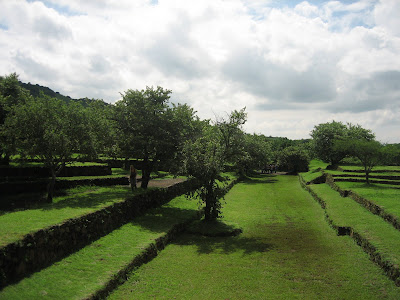
The construction dates to about 400 BCE and was only recently discovered. As was the case with much of the Mayan ruins in Belize and Guatemala, the 'pyramid' mounds remained completely unknown for so long because of the dense tropical vegetation grows so rapidly and engulfes everything.
Also, the structures were once much taller and larger, but over the years, stones have been purloined to construct various buildings in the town, such as the church and main plaza. I suppose that's good. At least they serve a useful purpose now, and one can still appreciate the grandure of the lost civilisation.

 Still more ruins remain uncovered in the thick forests of the surrounding mountains partly due to lack of state funding and partly because ruins are, well, just sort of everywhere in Mexico and aren't always considered worthy of recognition.
Still more ruins remain uncovered in the thick forests of the surrounding mountains partly due to lack of state funding and partly because ruins are, well, just sort of everywhere in Mexico and aren't always considered worthy of recognition.Almost always, Mexican civilisations aligned their urban layout to cardinal or astronomical positionings. While strict alignment is not as evident here in Guachimontones, the city is definitely and purposefully planned. The steps of the pyramids reflect months and days of the year illustrating how advanced their calendar system was.


You have to imagine that all of the stonework was stuccoed. So it would have looked much different. And nothing is known about whether the lawn is authentic. As you can see, lots of young trees are growing among the ruins. Either self-seeded or purposefully planted, it obviously is not representative of what originally existed.
Neither ancient or ruinous, these mexican guys were just hanging around.

No comments:
Post a Comment